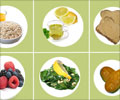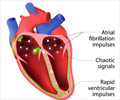- Atrial fibrillation or heart flutter is the most common form of abnormal heart rhythm and a major cause of heart failure and stroke.
- Moderate consumption of dark chocolate may lower the risk of atrial fibrillation, finds a new study
- Link between chocolate consumption and atrial fibrillation was strongest for one serving/week for women and 2-6 servings/week for men
Chocolate Consumption Linked to Lower Risk of Atrial Fibrillation
Studies have shown that regular consumption of chocolate, particularly dark chocolate can improve heart health. For the current study, the research team hypothesized, whether chocolate consumption might also be associated with a lower rate of atrial fibrillation.The research team from Beth Israel Deaconess Medical Center and Harvard T H Chan School of Public Health, Boston, Massachusetts, collected data from the population-based Danish Diet, Cancer and Health Study. The study involved 55,502 (26,400 men and 29,100 women) participants, aged between 50 and 64 years.
The participants’ weekly chocolate consumption was analyzed. One ounce or 30 grams of chocolate is one serving. Most of the participants consumed milk chocolate which contains minimum 30 % cocoa solids.
Information on heart disease risk factors, diet, lifestyle, and smoking habits of the participants was assessed. The health status of the participants was tracked using national registry data on episodes of hospital treatment and deaths.
During the monitoring period of 13.5 years, 3346 new cases of atrial fibrillation were diagnosed.
- One weekly serving of chocolate consumption lowered the risk of atrial fibrillation by 17 %
- 2 to 6 weekly servings of chocolate lowered the risk by 20 %
- 1 or more daily servings lowered the risk by 14 %
One weekly serving of chocolate lowered the risk of atrial fibrillation in women by 21 %. However, in men, 2 to 6 weekly servings lowered the risk by 23 %.
The authors said that no firm conclusions could be drawn because it is an observational study. Though associations have been found between chocolate consumption and heart health, milk may lower the levels of beneficial compounds in chocolate. Chocolates are mostly added to high-calorie products containing fat and sugar, which are known to have negative effects on heart health.
“Despite the fact that most of the chocolate consumed in our sample probably contained relatively low concentrations of the potentially protective ingredients, we still observed a robust statistically significant association,” said authors.
In an editorial, doctors from the Duke Center for Atrial Fibrillation in North Carolina, USA, highlight that chocolate eaters who participated in the study were healthier and more highly education (factors that are associated with better heath which might have influenced the findings).
Other risk factors for atrial fibrillation such as kidney disease and sleep apnea (breathing difficulty at night) were not taken into account. The study included only diagnosed cases of atrial fibrillation, making it difficult to determine, if chocolate consumption is associated with a lower risk of atrial fibrillation.
They also suggested that cocoa solids vary in different parts of the world, so the findings might not apply in countries with lower levels.
Sea Pokorney and Jonathan Piccini said, "Regardless of the limitations of the Danish chocolate study, the findings are interesting and warrant further consideration, especially given the importance of identifying effective prevention strategies for atrial fibrillation.”
How Chocolate Consumption Benefit Heart Health?
Moderate consumption of chocolate and cocoa-containing foods may promote heart health due to their high content of flavanols, a polyphenolic compound with vasodilatory, antioxidant and anti-inflammatory properties.Dark chocolate contains higher flavonoid content than milk chocolate and thus yield greater cardiovascular benefits. A study found that dark chocolate may have a higher caloric content than milk chocolate, however, dark chocolate promotes greater satiety and lowers the desire to eat something sweet, resulting overall lower calorie intake.
Atrial Fibrillation
Atrial fibrillation, also known as irregular heartbeat affects more than 33 million people globally. In the United States, more than 2.7 to 6.1 million people have this condition. The exact cause of atrial fibrillation is unknown. Atrial fibrillation increases the risk of stroke, heart failure, cognitive decline, dementia and premature death. Identifying methods for preventing and treating atrial fibrillation is of great public health importance.Reference:
- Elizabeth Mostofsky, Martin Berg Johansen, Anne Tjønneland, Harpreet S Chahal, Murray A Mittleman, Kim Overvad. “Chocolate intake and risk of clinically apparent atrial fibrillation: the Danish Diet, Cancer, and Health Study,” Heart (2017) DOI: http://dx.doi.org/10.1136/heartjnl-2016-310357
















